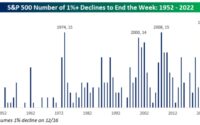Regional Bank Turmoil In The U.S. Is Far From Over
The more rates have risen, the more that regional bank stocks have declined.
Interest rate hikes by key central banks around the world and tightening credit conditions will put pressure on U.S. regional banks’ capital, credit quality, and profitability. Globally systemically important banks (G-SIBs) are benefiting from the diversity of business lines they have, as well as from the various sources of funding they can access. However, many regional banks, by definition, do not have the asset diversity and funding advantages that G-SIBs enjoy.
S&P Regional Banks Select Industry Index
Investors still have not regained trust in regional banks as evidenced by regional bank indices. The S&P Regional Banks Select Industry Index, for example, has declined 36% since the beginning of this year. I can understand the desire to blame short-sellers for this decline; yet, banks’ financials are showing that regional banks are still vulnerable to this elevated interest rate environment. Of particular concern are banks where assets and deposits have grown quickly. As I pointed out a few weeks when I wrote about Silicon Valley Bank and First Republic, rapid growth in both always worries me that bank risk managers are not ready for when there are significant mismatches in assets and liabilities. Certainly, we have now seen that a rising interest rate environment has lowered the value of the assets considerably; that has influenced many depositors to flee not only looking for higher rates elsewhere, but also in some cases for safety.
Weaker Regional Banks’ Financial Performance Expected
In a data-rich report released Tuesday by Fitch Ratings, “U.S. Banks’ Near-Term Deposit Challenges to Pressure Profitability, Credit and Capital,” analysts wrote they continue to expect weaker financial performance from banks throughout 2023. Already in November 2022, the Fitch Ratings analysts had changed their outlook on banks from neutral to deteriorating.
Cumulative Weekly Flows Through April 26, 2023
While many regional banks have benefitted from rising rates, they are now having to pay depositors more to retain them. Even then, deposits are still declining, albeit at a smaller rate than in March. To keep deposits and to attract new ones, banks’ net interest margins will decline at many regional banks, since their interest expenses will continue to rise.
Deposit Flows Stabilizing Since 1Q23
Even when the Federal Reserve pauses rate hikes, they are still high enough to pressure banks’ earnings. On May 5th, for example, Fitch Ratings put PacWest Bancorp
PACW
Also of concern is that most banks, including G-SIBs, raised their loan loss provisions in anticipation of deteriorating economic conditions. While this is prudent risk management, this also puts pressure on their profitability. Most banks’ loan portfolios are still of reasonably good credit quality. Yet, with rates as high as they are, I am expecting default rates to rise both for consumers and companies. When borrowers default, banks must charge off those loans and take the loss on their earnings.
Commercial Real Estate Concentrations for Fitch-Rated Banks at YE 2022
Understandably, with vacancy rates in office, there is significant concern about banks’ exposures to commercial real estate loans. While I share that concern, I am also still concerned about banks’ significant exposures to very leveraged companies. As I have written for Forbes in numerous columns, company executives have taken advantage of the relatively low interest rate environment from 2000-2021 to borrow at record levels. With rising rates, many of these companies are not going to be able to pay back their loans.
Keep An Eye On Bank Capital
Recent Fitch Bank Ratings Actions
Until now banks common equity Tier I, the highest quality capital to help banks sustain unexpected losses, has been higher than the minimum regulatory requirement. Yet, when a bank like PacWest announces a decrease in dividend payments, it tells me that it is trying to shore up its capital. Declining bank stock prices makes it harder for regional banks to raise capital.
As I have seen during multiple financial and sovereign crises during my career, banks should never be complacent with about their capital or liquidity levels. From where I sit, I am not seeing credible signals that the regional banking turmoil is anywhere near over. I can hardly wait to be able to say differently.
Other Recent Articles By This Author:
PacWest Bancorp’s Imminent Demise Shows Bank Turmoil Is Widening To Smaller Banks
The Federal Reserve’s Interest Rate Increases Create Default Risk In Major Sectors
With First Republic Takeover, JPMorgan Is America’s Most Globally Systemically Important Bank
To Know Why Silicon Valley Bank Failed, Congress Should Ask Former CEO Greg Becker
First Republic Bank’s Earnings Call Did Not Inspire Confidence
First Republic Bank’s Financial Ratios Will Reveal Serious Trouble
Regional Banks’ Financial Results Fail To Impress Investors
What To Watch For With U.S. Regional Banks This Week
Big U.S. Banks Are Preparing For An Impending Recession
Investors Eyes Should Be On Leveraged Finance Markets
Deutsche Bank Should Disclose Its Current Liquidity Levels To Investors
From Ferdinand Marcos To Russian Oligarchs, Troubled Credit Suisse Is A Repeat Offender
How Trump’s Deregulation Sowed the Seeds for Silicon Valley Bank’s Demise
Warning Signals About Silicon Valley Bank Were All Around Us
High Interest Rates Will Continue To Challenge Most Sectors Of The Economy
Leveraged Loan Default Volume In The U.S. Has Tripled This Year
Probability Of Default Is Rising For High Yield Bonds And Leveraged Loans
The U.S. Leveraged Finance Market Is At A Record $3 Trillion
[ad_2]
Source link


